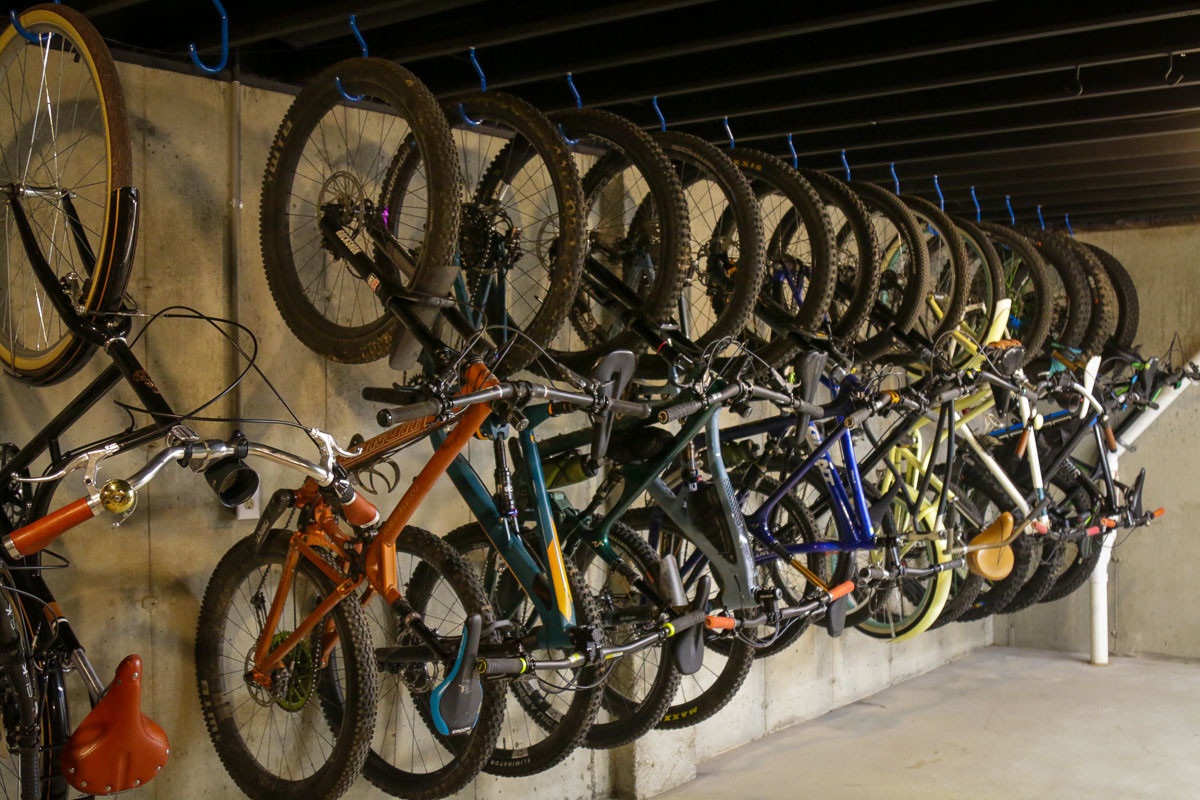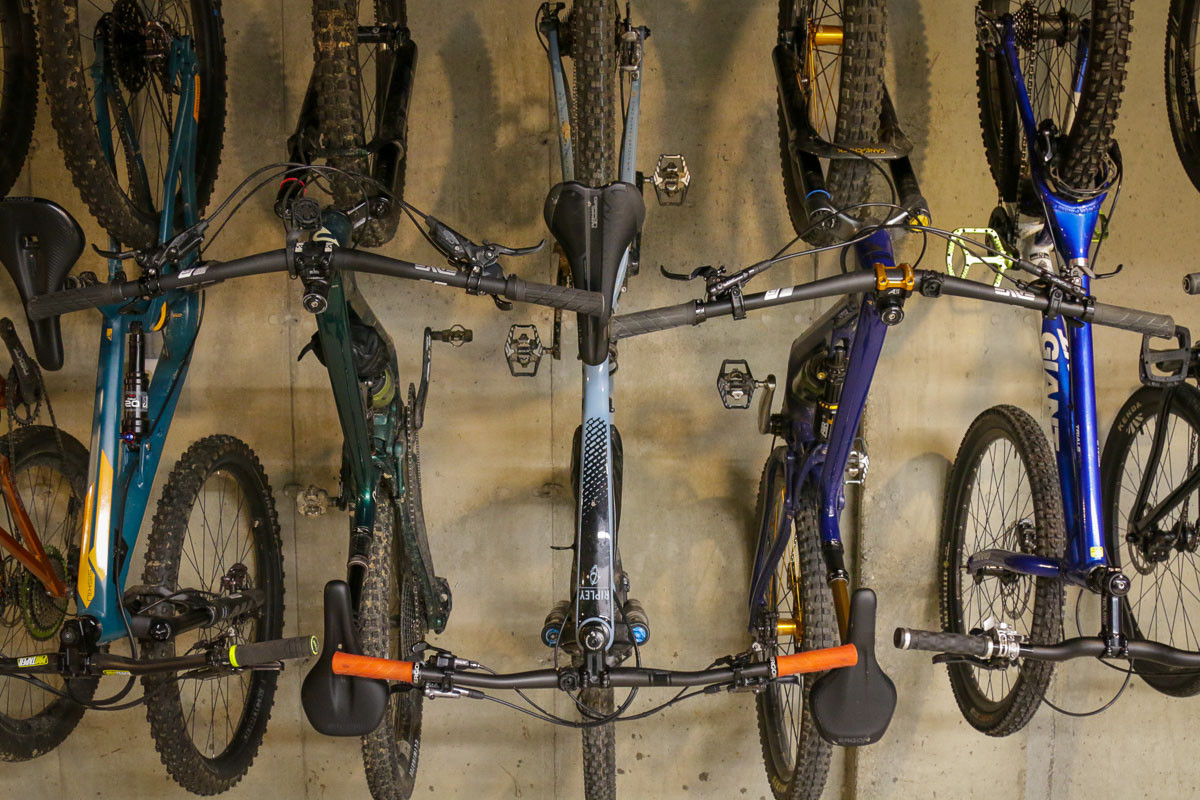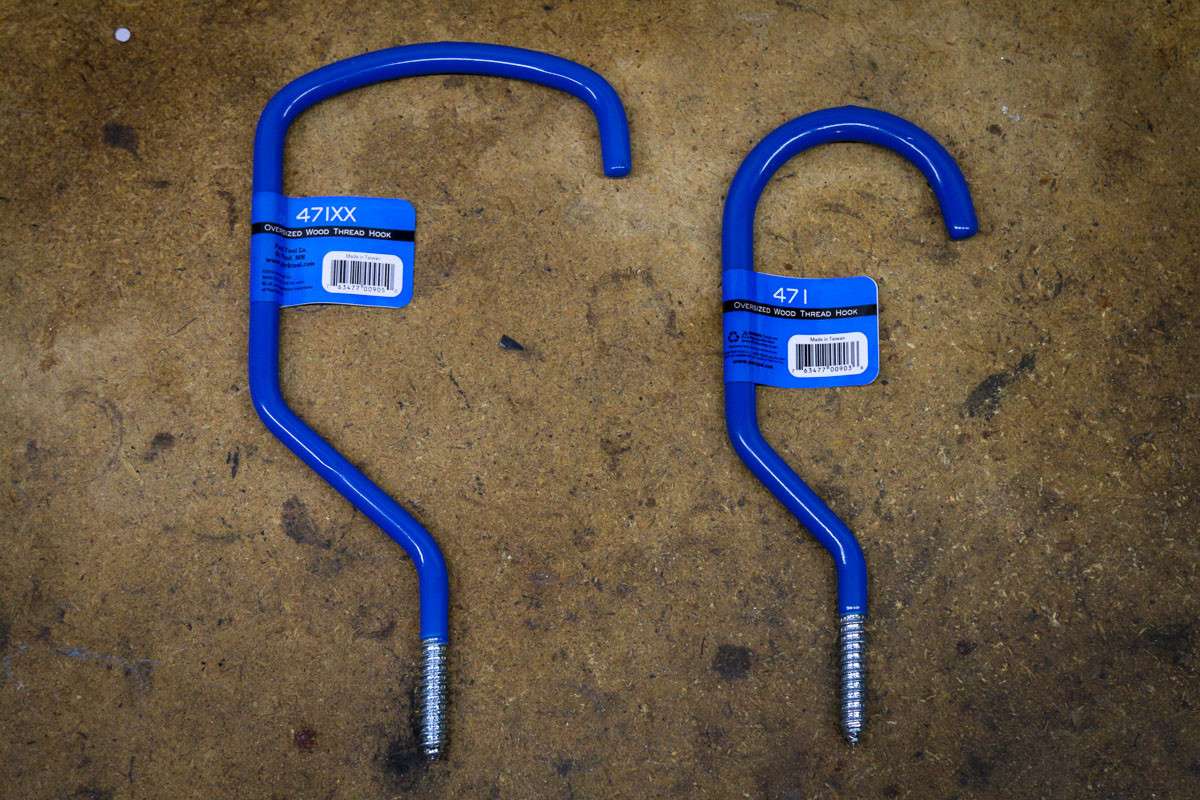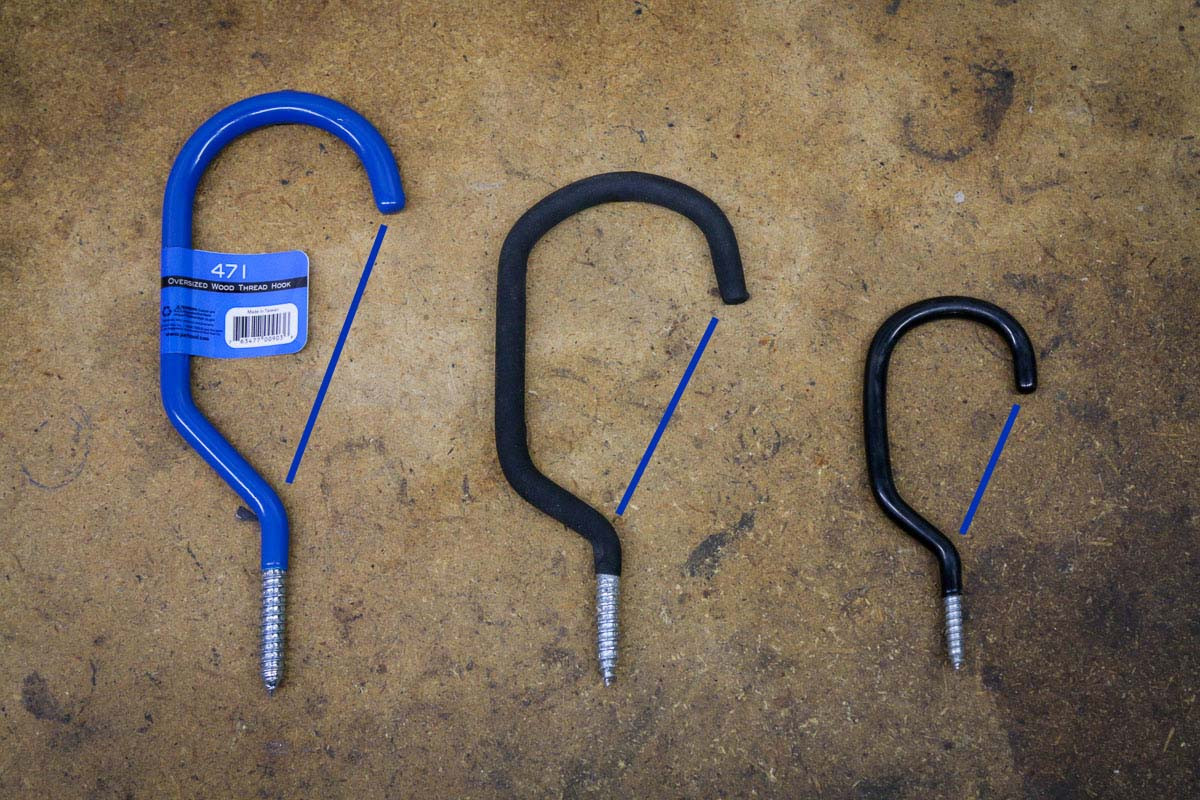Tired of tripping over bikes cluttering your garage or living space? If you’re a cyclist, the rule of n+1 (where ‘n’ is the number of bikes you currently own) likely resonates deeply. As your bike collection grows, finding efficient storage solutions becomes crucial. While various bike storage options exist, one of the simplest, most space-saving, and cost-effective methods is to Hang Your Bike From The Ceiling.
This guide dives into why ceiling bike storage hooks are an excellent choice for cyclists of all levels. We’ll explore the benefits, address common concerns about hanging bikes, and review the advantages of using specialized bike storage hooks like those from Park Tool to optimize your space and protect your valuable rides.
Why Choose Ceiling Hooks to Hang Your Bike?
 Park Tool Bicycle Storage Hooks vertical bike storage hanging
Park Tool Bicycle Storage Hooks vertical bike storage hanging
Ceiling bike storage using Park Tool hooks in a home garage setting, showcasing vertical bike hanging for space optimization.
When it comes to efficient bike storage, ceiling hooks offer a compelling combination of benefits that are hard to beat. Let’s break down why hanging your bike from the ceiling using hooks is a smart solution:
Space Efficiency: The most significant advantage of ceiling-mounted bike hooks is their incredible space-saving capability. By utilizing often-underutilized overhead space, you free up valuable floor area in your garage, basement, apartment, or shed. This is especially beneficial for cyclists living in smaller homes or those with multiple bikes. Instead of bikes leaning against walls or taking up floor space, they are neatly stored above, keeping walkways clear and your storage area organized.
Cost-Effectiveness: Compared to elaborate bike racks or storage systems, bike storage hooks are remarkably affordable. A set of sturdy hooks costs significantly less than floor stands, wall mounts, or specialized bike storage cabinets. This makes ceiling hooks an accessible storage solution for cyclists on any budget. For a minimal investment, you can achieve significant space optimization and bike organization.
Simplicity and DIY Installation: Installing bike storage hooks is a straightforward DIY project that requires minimal tools and effort. Most ceilings, particularly in garages and basements, have exposed joists or readily accessible framing. With basic tools like a drill and potentially a pilot drill bit, you can quickly install hooks and have your bikes hanging in minutes. The simplicity of installation makes it a user-friendly option for anyone, regardless of their DIY experience.
Accessibility and Convenience: While bikes are stored overhead, they remain easily accessible when you’re ready to ride. Simply lift your bike down from the hooks, and you’re ready to go. This is often more convenient than maneuvering bikes in and out of tight floor racks or wall mounts, especially when storing multiple bikes.
Addressing Common Concerns: Is it Safe to Hang Bikes Upside Down?
 Hanging mountain bikes upside down on a storage hook
Hanging mountain bikes upside down on a storage hook
Three mountain bikes with wide handlebars are efficiently hung upside down using ceiling hooks, demonstrating effective spacing.
A common question among cyclists considering ceiling hook storage is whether it’s safe to hang bikes upside down, particularly concerning hydraulic brakes and potential damage to components. Let’s address these concerns:
Hydraulic Brakes and Hanging Bikes: Worries about hydraulic brake performance after hanging bikes upside down are often based on outdated information or misconceptions. Modern hydraulic disc brakes are designed as closed systems and are generally unaffected by hanging orientation. To confirm this, manufacturers like SRAM, Shimano, and Hayes/Manitou have weighed in, stating that hanging bikes with hydraulic disc brakes is perfectly acceptable.
While Shimano and Hayes suggest that hanging bikes with brakes pointed upwards (front wheel down) might be marginally better “just in case” there is any air in the master cylinder, they emphasize that properly functioning hydraulic brakes should not be negatively impacted in either hanging direction. Any small air bubbles present in the reservoir are designed to naturally migrate back to the top and not interfere with braking performance. In fact, Shimano notes that hanging a bike can even aid in a self-bleeding process, helping air bubbles return to the reservoir.
The critical point to remember is to avoid pulling the brake lever while the bike is hanging upside down. This action could potentially force any air bubbles into the brake line, which might temporarily affect brake feel. However, even if this occurs, simply returning the bike to an upright position and pumping the brakes a few times should resolve the issue.
Carbon Rims and Hook Storage: Another concern, particularly for owners of high-end bikes, is whether hanging a bike by its wheels on hooks can damage carbon rims. While most modern carbon rims are robust and designed to withstand typical riding and storage stresses, there were older, more fragile carbon wheel designs that could be susceptible to damage if hung improperly.
These older, less common carbon rims often featured a thin carbon “fairing” over a standard rim structure. These could be more vulnerable to pressure. However, contemporary carbon rims are built with significantly stronger and more durable construction.
Generally, if your carbon wheels feel solid and robust, hanging them on hooks should not pose a problem. However, if you have any uncertainty about your specific wheels, it’s always best to consult the wheel manufacturer for their recommendations. When using hooks, it’s also wise to be mindful of valve stems and rim graphics, ensuring the hook doesn’t rest directly on these potentially delicate areas. Positioning the hook on a plain section of the rim is a simple precaution.
Park Tool Bike Storage Hooks: What Makes Them Stand Out?
 Park Took 471 471XX bicycle storage hooks
Park Took 471 471XX bicycle storage hooks
A close-up of Park Tool 471XX and 471 bike storage hooks, highlighting their robust construction and blue vinyl coating.
While basic hooks from a hardware store can technically be used to hang bikes, investing in bike-specific hooks like those from Park Tool offers several advantages that enhance both bike protection and ease of use. Park Tool, a renowned name in bicycle tools and equipment, designs its storage hooks with cyclists’ needs in mind.
Variety of Hook Types and Sizes: Park Tool offers a range of hooks to accommodate different bike types and mounting preferences. They provide hooks with both wood threads for direct installation into wooden joists and machine threads for mounting to metal surfaces or custom structures. This versatility ensures compatibility with various ceiling constructions.
Furthermore, Park Tool offers hooks in different widths to accommodate various tire sizes, from narrow road bike tires to wide mountain bike and fat bike tires. Their size range includes:
- 450/451 (Narrow): Ideal for road bikes and bikes with narrower tires.
- 470/471 (Standard): A versatile option suitable for road bikes, mountain bikes, and plus-size bikes.
- 470XX/471XX (Wide): Designed for fat bikes and bikes with very wide tires.
Choosing the appropriate hook size ensures a secure and stable hold for your bike without excessive pressure on the rim or tire.
Enhanced Design for Easy Use and Bike Protection: Park Tool hooks are distinguished by design features that prioritize ease of use and bike protection. One key difference is the larger opening and increased gap from the hook tip to the shoulder. This wider opening makes it significantly easier to guide the bike wheel into the hook, especially for bikes with larger tires and aggressive tread patterns. Generic hooks often have a narrower opening, requiring awkward tilting and maneuvering to get the wheel properly seated.
 Park Tool Storage hook benefits
Park Tool Storage hook benefits
Diagram highlighting the wider opening and shoulder gap of Park Tool hooks compared to generic hooks, for easier bike loading and unloading.
Additionally, Park Tool’s wider hooks, particularly the 470/471XX models, feature a curved bottom. This curved design provides a greater contact surface area with the rim, reducing pressure points and minimizing the risk of damage, especially to delicate rims. Many generic “ladder hooks” intended for flat objects have a flat bottom, concentrating pressure and potentially damaging rims over time.
All Park Tool hooks are coated in a durable, protective vinyl that prevents scratches and damage to your rims. This is a crucial feature, especially for protecting painted or carbon rims from abrasion.
Simple Steps to Hang Your Bike from the Ceiling
While specific installation may vary slightly depending on your ceiling structure and hook type, here are general steps to hang your bike from the ceiling using hooks:
- Locate Ceiling Joists: Identify the ceiling joists in your garage or basement. These are typically spaced 16 or 24 inches apart. A stud finder can help locate joist edges, or you can often identify them by looking for nail or screw patterns in the ceiling.
- Determine Hook Spacing: Decide how far apart to space your hooks. A spacing of 16 inches is often suitable, allowing enough room for handlebars, even wider mountain bike bars. Consider alternating bike hanging directions (front wheel in, then rear wheel in) to maximize space efficiency.
- Drill Pilot Holes: Using a drill bit size recommended by the hook manufacturer (usually 1/4″ or 11/32″), drill pilot holes into the center of the joists at your marked locations. Pilot holes make installation easier and prevent wood splitting.
- Install Hooks: Thread the bike storage hooks into the pilot holes, turning them clockwise until they are securely fastened. Avoid over-tightening.
- Hang Your Bikes: Lift your bike and carefully place a wheel onto the hook. Ensure the hook is securely supporting the rim, and repeat for the second hook.
Final Thoughts: Elevate Your Bike Storage
Fat bikes of various tire sizes are neatly organized using Park Tool 471XX hooks, demonstrating their capacity for large bikes.
Hanging your bike from the ceiling with hooks is an undeniably practical and efficient storage solution. It maximizes space, is budget-friendly, and is easy to implement. While basic hooks will work, investing in quality, bike-specific hooks like Park Tool’s offerings provides added benefits in terms of bike protection, ease of use, and long-term durability.
So, if you’re seeking to declutter your space and organize your bike collection, look up – ceiling bike storage hooks might be the perfect solution to elevate your bike storage game.

